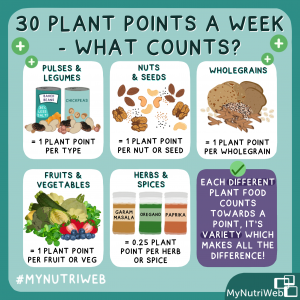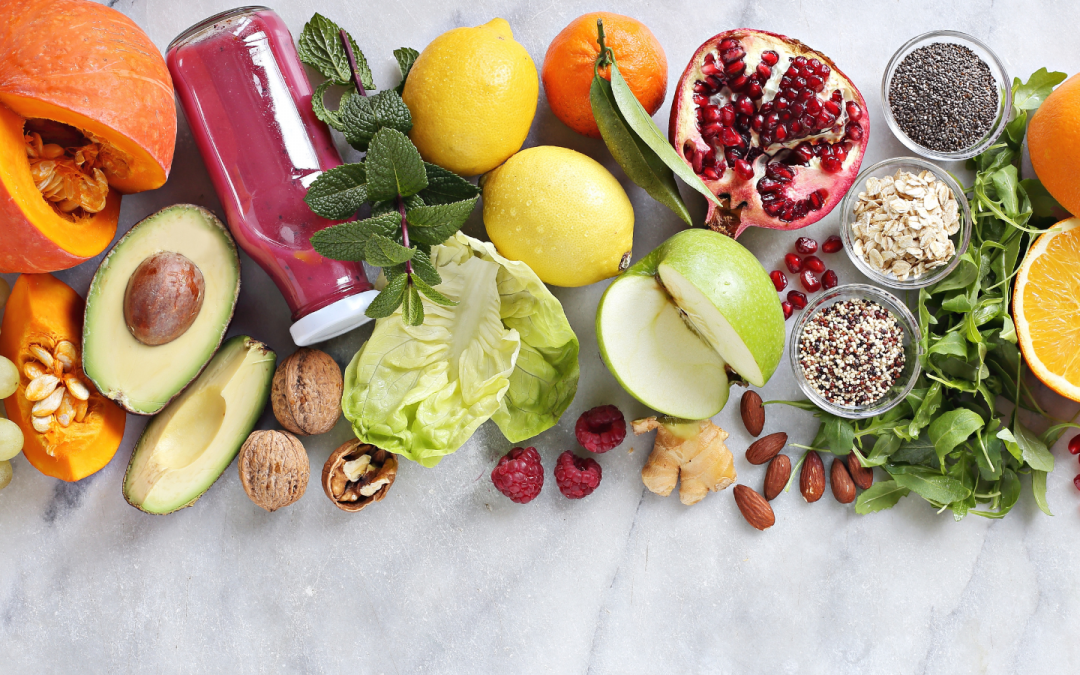
Interest in gut health has exploded over recent years, and 30 plant points a week has quickly become the new five-a-day. You might have heard that eating a varied diet is beneficial to our health, but have you ever wondered where the number 30 came from? We’ve asked Registered Dietitian Kaitlin Colucci to dive into the research, what it means for you, and some helpful tips on how to best support your gut including a delicious plant-based recipe.
Where it all started
The idea that dietary diversity can benefit our health, and that our gut microbes may be involved, has been floating around in research circles since the early 2000’s. However, in 2018, one of the biggest and most important studies to date testing just that, was published. The American Gut Microbiome Study collected stool samples from over 10,000 people from 45 countries across the globe (although primarily the US, UK and Australia) and investigated the complex relationships between their health, diet and lifestyle. Among many interesting conclusions, they found that participants who ate 30 (or more) different types of plant-based foods per week had a more diverse microbiome than those who ate less than 10. Greater microbiome diversity has further been shown to reduce the risk of conditions such as obesity, type-2 diabetes and aging-related diseases like Alzheimer’s.
Can we trust the research?
As with most research studies, some limitations can be found, e.g. the dietary data was self-reported and hence an element of bias cannot be ruled out. However, with a data set of this size and coming from diverse populations (considering the country of origin, sex, ethnicity but also rural vs industrialised environments), the findings remain very significant. Although further research is needed, other studies have been able to show that we can effectively manipulate our microbiome with dietary changes.
What counts as a plant point?
Now that we know that hitting the magic 30 can help gut health and overall health, how do we count the plant points?

| Fruits and vegetables | Each different fruit and vegetable counts as 1 point. Reassuringly, different varieties count as separate point, e.g. iceberg lettuce is different to romaine. However, if you had an apple on Monday and Tuesday, it still counts as 1 plant point that week. |
| Whole grains | All whole grains such as wheat, brown rice, buckwheat, rye, quinoa, millet, oats and whole-grain products such as pasta or bread count as 1 point. White pasta, bread or rice are not included due to the processing they undergo, stripping them of many nutritional benefits. |
| Pulses and legumes | Chickpeas, different kinds of beans and lentils each count as 1 plant point. For example, if you had a four-bean salad you would have eaten 4 plant points in that one portion. |
| Nuts and seeds | All your nuts, e.g. almonds, walnuts, cashews, etc. – each count as 1 plant point. Similar to the beans example, a bag of mixed nuts often contains 4-5 plant points per portion. |
| Herbs and spices | Let’s not forget that herbs and spices are plants too. However, because the quantities we tend to eat are rather small, each different herb and spice counts as ¼ of a plant point. |
What about portion sizes?
Each different plant based food counts towards a point, no matter the portion size, as it’s the variety of food which makes all the difference. However, remember that a portion of fruit and/or vegetables for 5-a-day is roughly 80g.
Are 30 plant points a week realistic?
While eating 30 different plant-based foods a week may sound like a major challenge, when you count all the whole grains, herbs and spices it suddenly becomes much more achievable. Before implementing any changes to your diet, calculate how many plants you’re already eating. You may be surprised! Then aim to add an additional 5 plant points per week until you’ve reached the 30 total.
How do I increase my plant diversity?
Most of us tend to stick to a couple of meals and recipes that we love and know well. Because of this, diversifying our diet can be harder than we initially expected. These handy tips will help you to eat 30 different plants a week without even noticing it.
- Go for a bag of mixed salad leaves instead of only iceberg lettuce. It can take you from 1 to up to 8 plant points.
- Diversify your snacks. Go for a mixed bag of nuts and dried fruit (up to 8-10 plant points), crudités and dip or mixed fruit salad.
- Include different colours of the same veg – e.g. instead of buying 3 red bell peppers, go for a red, yellow and green mix. The different coloured fruit and vegetables count as a new point.
- Try quirky pastas – in most major supermarkets you can now find lentil, buckwheat and even pea-based pastas.
- Remember that fresh, dried and tinned fruit and vegetables all count (try and opt for those with no added salt and sugar).
- Add a variety of beans and lentils to your meat-containing meals, either instead of the meat or on top. Puy lentils work great in a bolognese, chickpeas in a curry, and mixed beans in a quesadilla!
- For more great tips, check out this article from The Gut Stuff, who also offer free resources to track your plant points, and sign up to my newsletter to receive a FREE plant point checklist.
To prove that loading your meals with plant points doesn’t have to be complicated, have a look at the recipe below.
Smoky romesco coconut sauce with miso aubergine and mixed grains
This recipe is bursting with 18 plant points! I’ve served my romesco sauce with miso roasted aubergine, roasted chickpeas & asparagus, and 7 mixed grains.
Serves 2
Ingredients
For the sauce:
- 450g roasted peppers from a jar, drained
 100g toasted almonds
100g toasted almonds- 3 tbsp coconut yogurt
- 1 tbsp white wine vinegar
- 1 tsp smoked paprika
- 1 tbsp olive oil
- Pinch of salt
For the plate:
- Packet of cooked rice and/or mixed grains
- 1 aubergine cut in half lengthways and scored
- 2 tsp miso paste
- 1 can chickpeas
- 1 tsp smoked paprika
- 8-10 asparagus spears
- 1 tsp mixed seeds
- 1 tsp chopped parsley
- Salt & pepper to season
- Olive oil
Method
For the sauce:
- Drain the red peppers and tip into a food processor with the almonds, vinegar, smoked paprika, and 1tbsp olive oil, then blitz to a chunky paste.
- Season well, adding a little more vinegar and/or olive oil to get your desired consistency and taste.
For the plate:
- Drizzle the aubergine with olive oil and 1 tsp miso paste on each side. Roast in a preheated oven at 180c for 30 mins.
- Drain and rinse the chickpeas. Place onto a baking sheet and coat in the paprika. Roast for 20 minutes.
- When there is 10 minutes left on the timer, add in the asparagus with a drizzle of olive oil.
- Once everything is ready, heat the rice for 2 minutes. Serve with the romesco sauce, aubergine, chickpeas, asparagus, and sprinkle with mixed seeds and parsley.
Take home message
While gut health is not as black and white as focusing on a single number, aiming to exceed 30 plant points a week can be a great motivation to diversify your diet with many research-backed benefits to our health. If the big 30 seems daunting to start with, start small and gradually build up to meet the target using the tips above. As always in nutrition, consistency over perfection!
LINKS TO RELEVANT MYNUTRIWEB CONTENT
The Diversity Diet (2022), MyNutriBookClub – Book club with Dr Megan Rossi exploring her latest book


 100g toasted almonds
100g toasted almonds




Good research with helpful tips and how best to support your gut. The ideas and foods included can benefit healthy gut. Also it was mentioned that it reduces the risks of obesity, type 2 diabetes and aging related disesases.
Does wine count in 30 plants?
Here’s hoping!
I’m afraid wine doesn’t count